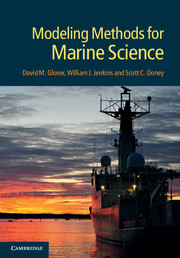Book contents
- Frontmatter
- Contents
- Preface
- 1 Resources, MATLAB primer, and introduction to linear algebra
- 2 Measurement theory, probability distributions, error propagation and analysis
- 3 Least squares and regression techniques, goodness of fit and tests, and nonlinear least squares techniques
- 4 Principal component and factor analysis
- 5 Sequence analysis I: uniform series, cross- and autocorrelation, and Fourier transforms
- 6 Sequence analysis II: optimal filtering and spectral analysis
- 7 Gridding, objective mapping, and kriging
- 8 Integration of ODEs and 0D (box) models
- 9 A model building tutorial
- 10 Model analysis and optimization
- 11 Advection–diffusion equations and turbulence
- 12 Finite difference techniques
- 13 Open ocean 1D advection–diffusion models
- 14 One-dimensional models in sedimentary systems
- 15 Upper ocean 1D seasonal models
- 16 Two-dimensional gyre models
- 17 Three-dimensional general circulation models (GCMs)
- 18 Inverse methods and assimilation techniques
- 19 Scientific visualization
- Appendix A Hints and tricks
- References
- Index
5 - Sequence analysis I: uniform series, cross- and autocorrelation, and Fourier transforms
Published online by Cambridge University Press: 05 June 2012
- Frontmatter
- Contents
- Preface
- 1 Resources, MATLAB primer, and introduction to linear algebra
- 2 Measurement theory, probability distributions, error propagation and analysis
- 3 Least squares and regression techniques, goodness of fit and tests, and nonlinear least squares techniques
- 4 Principal component and factor analysis
- 5 Sequence analysis I: uniform series, cross- and autocorrelation, and Fourier transforms
- 6 Sequence analysis II: optimal filtering and spectral analysis
- 7 Gridding, objective mapping, and kriging
- 8 Integration of ODEs and 0D (box) models
- 9 A model building tutorial
- 10 Model analysis and optimization
- 11 Advection–diffusion equations and turbulence
- 12 Finite difference techniques
- 13 Open ocean 1D advection–diffusion models
- 14 One-dimensional models in sedimentary systems
- 15 Upper ocean 1D seasonal models
- 16 Two-dimensional gyre models
- 17 Three-dimensional general circulation models (GCMs)
- 18 Inverse methods and assimilation techniques
- 19 Scientific visualization
- Appendix A Hints and tricks
- References
- Index
Summary
Nothing so like as eggs; yet no one, on account of this appearing similarity, expects the same taste and relish in all of them.
David HumeGoals and examples of sequence analysis
Sequences of data, either in space or in time, appear all the time in ocean research. You may have a time series of measurements at a location (e.g. sediment trap data, or ocean surface temperature), a series of stations along a hydrographic section, or isotope measurements on a long sediment core. For the sake of simplicity (initially) we shall discuss only regularly sampled data; that is, samples taken at identical intervals in space or time. The analysis becomes more difficult and more complicated when we discuss irregularly spaced samples, but the principles are similar and best understood in terms of the simplest case first. What do we hope to achieve in the analysis of data sequences? There are as many reasons (or perhaps more) as there are data sequences. The next subsections outline briefly some of the major conceptual motivations.
Searching or testing for structure or periodicities
Within a single data set you might be looking or testing for changes in a system due to periodic forcing, for example the effect of seasonal changes on biological production, or the effect of lunar tides on shell-fish contamination. This may be extended to spatial regularity as well, in that you may be looking for evidence of large-scale Kelvin waves (rapidly propagating variations of the thermocline depth) on dissolved nutrients near convergence zones in the ocean.
- Type
- Chapter
- Information
- Modeling Methods for Marine Science , pp. 120 - 140Publisher: Cambridge University PressPrint publication year: 2011



